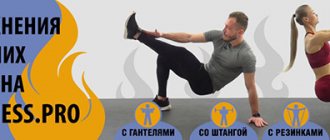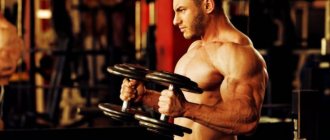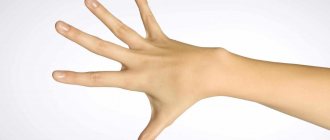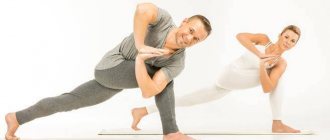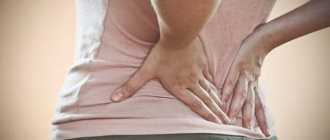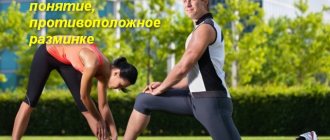Training for our body is a lot of stress, which the body is used to dealing with using typical means. That is why, if you get an excessively large load during the training process, you can easily get a number of very unpleasant symptoms: be it nausea or even fever after training. Why does it occur, how to deal with it and most importantly, how to avoid such an unpleasant consequence?
How long does it take to recover after training?
Each stage of recovery has its own nuances, the athlete must be aware of them in order to understand how to speed up recovery. If he is not interested in this issue, then over time the risk of stopping progress (training plateau) or chronic fatigue (overtraining) increases.
| Phase name | Onset time, duration | Features of the flow |
| Fast recovery | Lasts approximately half an hour after training | The functioning of the heart and respiratory organs is restored. The concentration of stress hormones (adrenaline, insulin, etc.) returns to normal. Wasted resources are restored: ATP, glycogen, creatine phosphate. |
| Slow motion | Starts after the first phase, lasts 1-3 days | Metabolic processes are restored, useful substances that are necessary for the regeneration of muscle tissue are absorbed faster. |
| Super compensation | Starts 2-3 days after classes, lasts up to 5 days | The muscles become bigger and stronger. Right now you need to conduct the next training to work the same muscle group so that it continues to develop. At this stage, the body needs nutrients. |
| Laid recovery | Occurs 5 days after phase 3 | There is a decrease in all physical parameters that increased during supercompensation. This stage occurs in the absence of quality training in phase 3. |
Now you know how many days it takes for muscles to recover, and how to influence the processes occurring in the body to ensure further muscle growth.
Not all athletes know how long it takes to recover biceps, triceps, abdominal muscles, and legs. According to experts, the larger the muscle, the longer it takes to grow together.
There are several phases of the muscle recovery process.
- The first phase begins immediately after the end of the workout and lasts about an hour. At this time, the body especially needs nutrients, necessary not only for further muscle growth, but also for replenishing energy reserves, after significant expenses. Therefore, during this period it is important to consume food and sports supplements based on proteins (amino acids) and carbohydrates. But this is only a partial recovery.
- Full muscle recovery can take anywhere from two to five days, and the larger the muscles trained, the longer they take to recover. For example, small muscle groups, such as biceps, triceps, are restored in 1-2 days, medium and large muscles: back, chest, legs, deltoids - up to 4-5 days. Although the duration of healing as a result of damage to muscle fibers depends on the resulting microtraumas. The recovery process also depends on the individual metabolic rate.
Drinking plain water between sets is essential for proper hydration and body temperature regulation. But adding carbohydrates or amino acids to your water will also improve your energy and well-being.
“Carbohydrates are the main source of energy for your muscles,” says nutritionist Paul Salter. – The harder and more intense you train, the more fuel your body requires in the form of carbohydrates. This is especially true for sports like powerlifting and bodybuilding, where short periods of time under tension are expected.”
But getting energy during exercise is just the beginning. “Carbohydrates have an anti-catabolic function. They minimize muscle breakdown,” Salter writes. – If consumed during training, they will reduce overall muscle damage from exertion. They have a positive effect on recovery time because fewer muscle cells are injured.”
To get maximum benefits, consume the “right” carbohydrates. Fast carbohydrates like glucose, dextrose or carbohydrate sports nutrition products are suitable for us. It is also important to consider the duration of the workout and the amount of carbohydrates consumed so as not to overload the gastrointestinal tract.
Carbohydrate intake during exercise
| Duration of training | Amount of carbohydrates | Amount of water |
| Less than 45 minutes | 0 grams | 500–750 ml |
| 45–60 minutes | 15–30 grams | 500–750 ml |
| 60–90 minutes | 30–50 grams | 750 ml |
| Over 90 minutes | 50–75 grams | 1 l |
Carbohydrates are great on their own, but when paired with branched chain amino acids (leucine, isoleucine, and valine), they become even better. Carbohydrates and BCAAs are designed to reduce muscle breakdown and cortisol levels, which is not the case with plain water. In addition, taking them before or during exercise will reduce post-workout pain.
Lack of sleep is a nightmare for your form. Brazilian scientists M. Dattilo and J. Antunes have proven that lack of sleep and poor quality of sleep can increase weight (“Sleep and muscle recovery: endocrinological and molecular basis for a new hypothesis,” 2011). This happens mainly due to increased hunger and appetite.
It is important not only the amount of night sleep (7-9 hours), but also its quality. To get the most out of your sleep, follow these tips:
- Keep the room temperature cool. Rooms without air conditioning that are located on the sunny side will heat up more in the summer and take longer to cool down. Use fans and cover windows.
- Use blackout curtains, especially in summer when the sun rises early in the morning.
- If noise outside the window or from neighbors prevents you from falling asleep, turn on a recording of nature sounds - they will help you relax.
- Don't forget about the phenomenon of sleep apnea syndrome (sudden cessation of breathing during sleep). This is a common occurrence among bodybuilders and athletes involved in strength sports.
Which sport should an active lady choose?
Gym
The more we load the muscles, the more intensely the body reacts, because exercise on exercise machines puts it in a state of stress. A sure sign of such stress is a characteristic burning sensation in the muscles being worked. At this moment, the endocrine system receives a signal: hormones are needed for recovery! The body sends these hormones directly to the part of the body that has just experienced “training” stress.
Strength training, in principle, helps your body look younger. The muscles become toned and stop sagging like limp rags. For ladies who practice regular squats with light weights, this effect is clearly visible in the buttocks, which are tightened, raised and acquire that seductive shape that attracts men's gaze. Thanks to the targeted action of hormones, strength training even helps get rid of the first stages of cellulite. The only main thing is not to overwork and not get carried away with “drying”. The optimal schedule is three strength training sessions per week for 45 minutes.
Swimming
In many ways it is inferior to the “rocking chair”. To achieve similar results, you will have to do more than just swim at a leisurely pace, posing as a regal undine. You will have to work with maximum intensity.
Regular, intense swimming exercises perfectly develop all muscle groups, with the main load falling on the back area. This shapes your posture and your entire figure. Lymph drainage is activated, which allows the body to quickly get rid of metabolic products, which, of course, affects the condition of the skin.
Unfortunately, in our latitudes, such activities are only possible in swimming pools, the water in which is disinfected with chemical reagents, which can affect sensitive skin. In some cases, the water is chlorinated, so moisturizers will be needed to restore the hydrolipid mantle.
Exercises borrowed from yoga
Mega-popular yoga is trending among people who want to look younger than their age. However, there are many caveats. Firstly, it is difficult to find a competent specialist who will actually teach yoga, and not a set of exotic body movements. Secondly, the desire to tighten your figure and improve your appearance is realized much faster in the gym - you can see the first positive changes in the mirror within three months. Thirdly, yoga as a teaching was created not for aesthetic purposes, but as a way of spiritual improvement and involves a radical change in many aspects of everyday life. The changes that occur in the bodies of adherents of this teaching are more of a side effect than the result they were striving for.
Stages of muscle recovery after training
Muscle recovery is a rather complex process that includes four important stages.
Rapid recovery begins within half an hour after you finish your workout. During training, the muscles burn the nutrients from which they are built. And after the training has been completed, the body recovers from stress and begins to return the muscles to their normal state.
During training, not only nutrients are burned, but also minor injuries to the muscle fiber occur. After training, their healing process occurs within two to three days. The body begins to intensively synthesize protein. In order for the recovery process to be more effective, it is necessary to ensure a sufficient supply of protein cells in the body.
Super compensation
This is the stage of very active construction of muscle protein in the body. If the workout was hard and at the limit of the body’s capabilities, then during recovery this process is started so that the next time the body has the opportunity to cope with the load better. This is an adaptation mechanism of our body, and in order for it to go off with a bang, it is also necessary to ensure the required amount of protein entering the body.
This is a process that starts when you miss training for a long time and sometimes when your intensity drops. The body always strives for consistency and stabilization, and if you have not trained for a while, then there is no point in the body spending its resources on maintaining increased muscle mass.
Dietary nutrition during fitness classes
The diet should be balanced, containing 50% complex carbohydrates for girls involved in fitness. Men should have 55-60% carbohydrates and 15-20% fat daily. Protein food consumption is calculated based on the intensity of physical activity, 1-1.5 grams per 1 kilogram of a person’s weight.
Proper nutrition for weight loss does not exclude tasty foods from the diet; the main idea involves the deliberate distribution of calories and healthy sources of nutrients. The first step on the path to losing weight is to analyze the state of the body. Before fitness training, it is necessary to measure your body mass index and calculate the number of excess kilograms. Nutritionists recommend a gradual transition to the right style of balanced nutrition.
Planning a Fitness Breakfast
Protein and essential amino acids should be sought in beef, chicken breasts, all dietary meats, and egg whites. A low glycemic index of carbohydrates is found in buckwheat, large oat flakes, legumes, and any cereals. Porridge must be cooked in water or skim milk.
During intense physical activity, the diet should be rich in fresh vegetables, eat fruits daily, preferably citrus fruits. The polyunsaturated fats the body needs are found in unrefined corn, sesame, vegetable oil, walnuts, fish oil, omega-3. During training and daily sports, you should limit the consumption of high-calorie foods that provoke a rapid increase in blood glucose levels.
Balanced lunch for an athlete
Lunch preparation should include limited inclusion of potatoes and beets - high-calorie foods with a large amount of quickly digestible carbohydrates and a low content of light fats. Buy cereals and pasta made from durum wheat. A portion of proteins can be represented by boiled fish or egg whites, dietary goat cheese.
The most useful greens are parsley, cilantro, spinach leaves, they are rich in vitamins and essential microelements that promote weight loss. When doing fitness or leading a sporty lifestyle, salads should be seasoned with flaxseed and olive oil.
Preparing a Healthy Sports Dinner
Feeding 2 hours before bedtime consists of low-fat cottage cheese 300-350 grams, dietary yogurt, kefir, fermented baked milk with the addition of a small amount of fruit. You can prepare oatmeal and buckwheat without adding animal fats.
It is necessary to maintain the body's water balance when playing sports or intense training. A balanced diet for an athlete who wants to be healthy requires adherence to a drinking regime. You should drink more than 1.5 liters of fluid during physical activity associated with increased sweating.
Methods for muscle recovery after training
There are active and passive muscle recovery.
- Passive recovery - complete rest and rest from any stress, that is, abstaining from them for 2-3 days or until complete recovery. This method is suitable for all athletes, especially if there are symptoms of overtraining. The only disadvantage of the method, if used frequently, is the lack of adaptation to new loads; the athlete stops developing.
- Active recovery - involves a set of active measures, such as: cardio exercise for 10-20 minutes after training, muscle stretching to remove lactic acid and toxins, as well as sports massage.
To summarize
When answering the question whether there can be a temperature after training, you need to understand that the temperature itself is not a problem - it is only a symptom of one of the reasons described above why it may increase. First of all, you need to measure the temperature itself, understand how intensely you trained, and did you come to the training session healthy to begin with?
If the reason is overtraining, then appropriate conclusions need to be drawn from this. If this is a normal reaction to cardio exercise, then it is enough to drink more fluid during the workout itself.
How sleep affects the body's recovery after exercise
Sleep is an important stage in the recovery of muscle tissue in athletes.
Lack of sleep has a negative impact on muscle growth and recovery. The fact is that at different periods (sleep or wakefulness) different types of hormones are active in the body.
Sleep time directly affects muscle recovery ability
During sleep, the hormone melatonin is produced, which helps slow down the aging process and reduce the percentage of body fat. Thanks to melatonin, fats are broken down into substances necessary for muscle growth. Serotonin is a hormone that helps transport amino acids into muscle tissue. Serotonin is not produced in the body directly during sleep, but its level is influenced, among other things, by the presence of melatonin in the body.
Lack of sleep affects the overall hormonal balance of the body. Plus, the body copes worse with stress factors and accumulates excess cortisol, which contributes to the reduction of muscle tissue and its breakdown into amino acids. Moreover, the training itself, especially hard training, is considered a stress factor for the body.
You need to sleep at least eight hours a day. Lack of sleep negatively affects the effect of training; muscles may simply stop growing because their full rehabilitation will not occur.
Favorable days and positive attitude
With such a nutritional system, metabolism slows down significantly, and after returning to a normal diet, the body begins to very carefully convert every calorie into fat cells and store them under the skin in case of another hunger strike.
In addition, even a week spent on buckwheat, apples, kefir or other low-calorie foods can cause irreparable harm to health. You need to choose only balanced and long-term diets, which, after stabilizing your weight, you can stick to for the rest of your life.
When you have decided on a diet, you must undergo a medical examination to make sure that you do not have any contraindications to following it. Only after this can you proceed to the next stage of preparation.
There is such a thing in dietetics as “favorable days” to start a diet. For women, this will be the first phase of the menstrual cycle, since it is at this time that metabolism accelerates, a surge of strength and energy is felt, and the body is in perfect order. During PMS, it is generally not recommended to start losing weight, since during this period hormonal surges can greatly affect your mood, and combining them with culinary deprivation, you can even fall into depression. Choose one of the Mondays at the beginning of your menstrual cycle and become slimmer from that day on.
Try to mentally prepare yourself for the fact that the diet will benefit you and become a reward for your body, and not a punishment for it. Don’t think that you won’t succeed; believing in yourself will not only cheer you up, but will also help you lose weight faster.
Psychological preparation includes the following points:
- attitude towards a positive result;
- perception of diet as improving the quality of life, and not as a punishment for gluttony;
- eating with pleasure and without self-flagellation;
- complete absence of irritating factors and psychological pressure.
httpv://www.youtube.com/watch?v=embed/Kx9tW0EBk34
What physical activity is acceptable when restoring muscles after training?
The benefits of cardio training after exercise is the acceleration of the removal of lactic acid from the muscles, that is, breakdown products, and this significantly speeds up recovery. Cardio should be light, without raising your heart rate to the limit. Walking on a treadmill, stepper, orbit track, as well as an exercise bike are suitable.
Stretching allows you to return your muscles to their normal state, maintaining their elasticity and preventing them from becoming stiff. Tight and stiff muscles are prone to injury and are slower to recover and grow.
The only thing is that such muscles need light stretching, but in no case dynamic and strong stretching, otherwise they can be easily injured, and they will not heal for several months.
For playing tennis
Your aim. Eat something small but nutritious to prepare for intense exercise and quick reactions.
Before. At least an hour should pass between the game and eating so that the food has time to digest at least a little. To speed up this process, use a blender: mix milk, banana, oatmeal and a little cinnamon - you have an energy shake. You can also eat a couple of boiled eggs: the lecithin they contain will sharpen your reflexes and improve coordination.
During. Drink half a liter of water or apple juice.
After. You need a combination of proteins, carbohydrates and vitamins, flavored with enough vegetable fats. Try making a salad of greens, tomatoes, fried chicken fillet and rye croutons. Dressing - olive oil and a small amount of salt. You can wash down all this beauty with a cup of herbal tea and a glass of juice.
Based on materials from The Daily Mail
Accelerating the recovery process after hard training
There are many ways to restore muscles after physical activity:
- Proper nutrition will help saturate the body with the necessary nutrients.
- Getting adequate sleep will speed up the healing and growth of muscle fibers.
- Massage will help muscles relax and speed up metabolic processes.
- Drinking regimen will help replenish the lack of fluids and minerals in the body.
- Multivitamins and sports supplements compensate for the lack of nutrients and accelerate tissue healing.
The next day after a hard workout, you may feel pain and discomfort in your muscles (whether it be your abdominal or pectoral muscles). This is due to the fact that muscle tissue is injured after training, and lactic acid accumulates in it, a substance that is formed chemically during the breakdown of glucose.
To speed up muscle recovery, you need to provide conditions under which lactic acid and other unnecessary substances are eliminated by the body faster. Recovery after training can be active or passive. Passive recovery is simply taking a break from training. And active recovery includes a combination of sports massage, a lighter version of training and gentle stretching of the muscles. Let's look at how this works.
If you are not happy with your partner’s weight, what should you do?
It often happens that obesity affects the husband/boyfriend, wife/girlfriend. It is stupid to end a relationship for this reason (if there are no other reasons), so it is worth knowing how to force your partner to take measures to lose weight.
Dissatisfaction with the girl's figure
If your beloved lady has extra pounds, then her partner should sound the alarm immediately. There are a number of recommendations for doing the right thing:
- If excess weight is not critical, then everything is simple: you need to give the girl not chocolate and trips to a restaurant, but a fruit basket and a vacation at the skating rink (for example). You need to replace the evening movie viewing with a walk in a nearby park, or replace the “add-on” in the form of pizza and cookies with sweets with sushi, grapes, strawberries, apples.
- Blaming a girl/wife for being too fat is not just stupid, but dangerous for the relationship. A man can force his partner to lose weight by his example! If he has a slim figure, no beer belly, and regularly plays sports, then the “lady of his heart” will simply be drawn to him and want to match him.
- Girls do not like sports and will not forcefully go to the gym. A man can use a trick: arrange a romantic bike ride with a picnic, get her interested in roller skating, give her a subscription to the pool.
Some psychotherapists believe that a girl can be motivated to lose weight by jealousy. But this is very dubious advice, because in this way you can disrupt the established relationship between partners. It would be much more effective to do it differently - take her to the beach, to a water park, where hundreds of slender ladies stay.
Of course, the man himself must behave in a dignified manner, then women’s envy will play into his hands - surely an attack of love for sports will happen the very next day. All that remains is to support your beloved in her endeavors and strengthen the process with proper nutrition.
If your husband has gained weight
The task of making an overweight husband lose weight is difficult, but with certain tricks it is quite realistic. What you should absolutely not do:
- Defiantly hang posters with Bruce Willis or the main character of “50 Shades of Gray” in the bedroom and throughout the house, and speak admiringly of every slender man around. This can only result in your partner becoming withdrawn, building up complexes, and possibly breaking off the relationship forever.
- Set ultimatums like “either lose weight or get a divorce,” “until you get yourself in order, we sleep in separate bedrooms,” and so on. Such statements can anger even an angel. Just 2 - 4 weeks of this behavior - and you can collect his things, the man will probably take a mistress or simply run away.
- Abruptly stop feeding your partner the usual foods. If a man does not find fried chicken, mashed potatoes and pies with cottage cheese on the table, then this can become a tragedy. Most likely, surprise will follow first, then persuasion, and it will all end with a secret protest - at work, while walking, he will consume fast food in huge quantities.
But there are also quite effective measures:
- Ask your partner to help you lose weight. Suffice it to say that you go on a diet and start preparing less fatty dishes, but you can’t cope without his help, as the “master of the situation” awakens in a man.
- Encourage him to take walks through parks, embankments and squares. And even if he sits down at a table in a cafe and drinks a cup of coffee, calories will still be burned. You can ask him to teach him how to ride a bicycle; for the sake of the result, it’s even worth pretending to be completely incompetent and entice him into daily training.
- Convince him of the need to improve his health in order to have a child together, go to the mountains in the summer, start growing vegetables in the country (this will bring a small income). And in general, “there’s an anniversary next year, you need to fit into a formal suit.”
We recommend reading about how to maintain weight after losing weight. From the article you will learn about recommendations and advice from nutritionists on how to behave after losing weight and avoid an eating breakdown.
And here is more information about how to speed up your metabolism for weight loss.
Forcing yourself or your partner to lose weight is difficult, but completely doable. You just need to use the recommendations of experts and apply little tricks, and the results will definitely appear.
Nutrition for muscle recovery throughout the day
- Breakfast: immediately after sleep - sports nutrition (amino acids or protein shake).
- After half an hour: simple complex carbohydrates (cereals: oatmeal, brown rice, wheat, corn honey, dried fruits, fruits).
- Snack: fruits or berries with cottage cheese.
- Lunch: Complex carbohydrates (fiber-rich grains), vegetables and greens, eggs or lean meat.
- Half an hour before training: full cycle amino acids.
- Immediately after training: BCAA.
- After half an hour: gainer or protein shake with banana milk. Or, instead of sports nutrition, eat carbohydrates (cereals, vegetables, fruits) and proteins (cottage cheese, eggs or meat).
- Dinner: Protein-rich foods (meat, poultry, fish, dairy products, eggs) vegetables with butter.
- Before bed: dairy products, amino acids or casein protein.
Throughout the day, and not just after strength training, athletes need more nutrients, vitamins and minerals than untrained people. The rate of absorption of nutrients from food is much slower than that of sports nutrition and pharmaceutical dietary supplements, therefore, for a speedy recovery and prevention of catabolism, it is necessary to provide “first aid” as a sports nutrition supplement.
A full cycle serving should be taken before training or before bed, while BCAAs are needed immediately after training and after a night's sleep. Amino acids not only accelerate muscle recovery and growth, but also prevent destruction under the influence of cortisol, which is produced after training and sleep.
Sports nutrition for those who are gaining muscle mass. In addition to essential nutrients, creatine and glutamine accelerate recovery and remove waste products. Take supplements immediately after training along with BCAAs.
Vitamins and minerals
During intense exercise, athletes need all the minerals and vitamins for muscle recovery, especially B vitamins, ascorbic acid, zinc, and magnesium. You can take courses of vitamin and mineral complexes designed specifically for athletes, following the dosages and manufacturer’s instructions.
What we eat becomes building material for the cells of our body. And, accordingly, if you want rapid muscle growth and progress during training, then you must monitor your nutrition.
It is important that the body receives the elements necessary for building muscles with food.
Equally important, and sometimes even more important, for the restoration of muscle tissue is how much we drink.
Water is a unique conductor and solvent of various chemical compounds in our body. With its help, all metabolic processes in the body are regulated, including the removal of elements unnecessary for the body and the supply of necessary building materials and nutrition to the cells.
The conductivity of our neurons also depends on the amount of water in the body. With a lack of moisture it worsens. Accordingly, we feel tired, less focused, and it becomes more difficult to perform simple exercises.
During exercise, our body heats up. We generate a lot of heat. And in order to compensate for the increase in body temperature, we sweat. A lot of water comes out with sweat. To feel good, it is important to consume no less water than we lose during training.
When building your own drinking regime, you can rely on the following principles:
- A person needs about 40 ml of fluid per kilogram of body weight per day.
- You need to drink about 0.5 liters of water a couple of hours before training. But without fanaticism, be guided by your feelings. If you have absolutely no desire to finish the recommended amount, do not drink. Excessive fluid intake can put additional strain on the heart.
- You also need to drink during training. You can take a couple of sips of liquid every 15–20 minutes.
- You can drink a glass of water 10 minutes before training.
- It is very important for recovery to drink about a liter of water within 4 hours after training.
To restore muscles, it is important to eat enough protein and carbohydrates. Protein is the building material for muscle cells, and carbohydrates serve as a source of energy and are also stored in the muscles and liver in the form of glycogen.
During exercise, glycogen is broken down to provide us with energy. Therefore, it is important to restore its reserves. And protein is necessary for the regeneration and growth of muscle tissue after training.
To ensure that your muscles have enough amino acids for recovery, you can use special nutritional supplements with BCAA amino acids, as well as proteins. But you shouldn’t overuse sports nutrition either; moderation is important in everything. It is advisable to discuss this measure with your personal trainer, because there are no universal recommendations.
To restore muscle fibers, it is important to eat both proteins and carbohydrates.
You should also organize your diet in such a way as to receive the substances necessary for muscle growth and recovery. Eat foods rich in proteins (eggs, dietary meat, legumes, nuts) and complex carbohydrates (cereals, honey, vegetables). Also, do not neglect the natural fats found in fish and directly pressed vegetable oils.
If you want to be in good shape, then do not forget about vitamin complexes. Vitamins such as:
- Vitamin A, which regulates protein synthesis in the body. The amount of vitamin A affects the speed of tissue regeneration processes, and this is directly related to muscle recovery.
- B vitamins affect not only the condition of hair, skin and the nervous system, but also improve intracellular metabolism and neuron conductivity. This all contributes to better muscle recovery after training and an overall increase in performance. Many trainers recommend that their clients consume B vitamins along with amino acids for better absorption.
- Vitamin E eases the post-workout condition, as it helps eliminate excess substances accumulated during training from the body. Also, vitamin E, like vitamin A, has a positive effect on the ability of tissues to regenerate.
- Vitamin C is a very powerful antioxidant that neutralizes the effects of many factors on our body and significantly reduces the severity of muscle pain. But that’s not all: vitamin C, moreover, is involved in the synthesis of testosterone, normalization of hormonal balance, and also stimulates the formation of collagen, an important protein for building our muscles.
- Vitamin D is also important for muscle growth as it helps increase testosterone in the body. Plus, this vitamin helps absorb calcium and magnesium from food, which, in turn, has a positive effect on overall endurance, performance and ability to recover.
In order for muscles to grow properly, it is important not only what we eat, but also when we eat and in what quantity.
Muscles recover effectively while we sleep. Therefore, shortly before going to bed, you can eat some easily digestible protein. It could be a protein shake or just cottage cheese, low-fat cheese, squid, etc.
Breakfast should also be rich in protein. Add eggs, chicken breast. But be sure to mix up your proteins with carbohydrates, as you may need a lot of energy throughout the day.
Before strength training, you can also eat some protein foods or drink a shake. After exercise, you are allowed to eat about an hour later, and you should eat a lot of protein, as well as carbohydrates, to replenish lost energy reserves.
Drinking regime during training
You need to play sports according to the rules, for example, drink a lot even when you don’t feel like it. It is advisable to start training with a glass of water. Then drink a little every 15 minutes. Why is this necessary? When performing exercises, the body loses a lot of fluid through sweat. Due to dehydration, the overall health of the athlete worsens. Initially, there is a feeling of dry mouth and a feeling of thirst. Then there is a loss of strength and dizziness. With prolonged lack of water, irritability increases and appetite disappears.
Thus, it is not so important whether you exercise before or after meals. The main thing is to follow the rules of training and nutrition
In addition, you should pay attention to your food intake and the dishes on your table: the diet should be balanced, and the timing should comply with the recommendations of professionals
httpv://www.youtube.com/watch?v=embed/RUYZD_S_glk
Recovery with massage
Massage is wonderful. But often there is not enough money or time for it, and not many studies have confirmed its benefits for recovery. This does not mean that you should refuse a massage if you like it. For example, R. M. Tiidus in his work “Alternative treatment of muscle microtraumas” recommends massage after training. You can simply resort to a more affordable option, for example, self-massage using a roller.
Over the past few years, research has been conducted on the benefits of myofascial release. A 2020 Canadian study (“Rolling for muscle fatigue and recovery from dynamic exercise”) found that using a foam roller reduced post-workout soreness. The subjects performed self-massage on a roller immediately after training, 24 and 48 hours later.
Someone might think that a massage roller can be replaced with a regular stretch. But that's not true. The 2011 study by R.D. Herbert and M. de Norona, “Stretching as a Way to Prevent Muscle Soreness after Exercise,” found that stretching was ineffective in promoting recovery.
Sports massage is a procedure that greatly helps accelerate the recovery of muscle fibers. Massage has the following benefits:
- Massage, firstly, warms up the muscles again, and it is much easier to remove glucose breakdown products, in particular lactic acid, from them.
- During the massage, the muscles relax. This increases their ability to regenerate and heal microdamages formed during training.
- Massage improves blood flow and, accordingly, nutrition of body tissues. Muscle growth occurs due to the active division of muscle fiber cells. Muscle growth requires nutrients and oxygen. During the massage, the blood vessels dilate, while blood pressure remains at the same level. And it is much easier to deliver the necessary amino acids to relaxed muscles.
- Massage also has a beneficial effect on the nervous and hormonal systems. Tactile sensations help calm and reduce stress levels in the body. And, as a result, the body has the opportunity to direct more of its resources to muscle restoration and healing.
A sports massage, like a general wellness massage, should begin with light stroking of the skin, gradually increasing the pressure. To ensure smooth gliding, use massage oil or cream with a warming effect.
Promotes relaxation, improves blood circulation
When the muscles have relaxed enough and become soft to the touch, you can begin to knead them more intensively. Particular attention should be paid to the muscles that you trained.
During the massage, you need to note and take into account your sensations and adjust the massage depending on them. Pain may occur, especially if it is the first or second day after a hard workout. However, the pain should be tolerable, but if it is too strong, you need to ease the pressure.
Massaging your body is best left to professionals, but with some practice you can massage yourself yourself if we are talking about your legs or arms.
There is a wonderful method to increase mental strength - “collecting kilograms”
To do this, you should take any cereal (semolina, sugar, etc.) and determine the counting norm for yourself. For example: 1 kilogram – 1 spoon of cereal. When you lose a kilogram, boldly pour a spoonful of cereal into a separate jar (preferably with transparent walls). And so every time.
Over time, the jar will fill up, and your joy will simply know no bounds. You will be very sorry to interrupt your classes, and you will have an even greater desire to achieve even greater results.
How to practically endure the difficulties of the process
You should prepare for the diet in advance and set a goal. It is advisable to choose a time when there are no problems at work and everything is smooth in your personal life. The reason is that stressful situations often make you want to snack on something tasty and high in calories, or even drink a glass or two of wine.
- It is necessary to choose exactly the diet that will best suit your preferences and body needs. It is also worth buying electronic floor scales to check your weight daily. You should carefully read the menu that you will need to follow during the diet. You need to purchase all the necessary products in advance, and then make a plan for what dishes and when you will cook from them.
- To cope with your appetite, you should drink as much water as possible - thanks to this, the feeling of hunger will become noticeably less. If this does not help, you should snack on fruit or some of those foods that are allowed in the diet menu. When eating, you should not rush, you should chew food slowly, and take the food itself in small portions. While eating, you should not read magazines or watch TV. You need to fully concentrate on food so as not to miss the moment when you are completely full.
- It is advisable to find like-minded people who also adhere to some kind of diet, who will be able to help you morally in time if you want to quit this business. If you were unable to find such people in your real environment, do not despair - in the Internet era it is easy to find the right people in a few minutes.
- If your mood has completely dropped and you have a desire to give up everything, think about what a beauty you will become when you find the desired, beautiful and slender body. Or that you can get rid of many diseases associated with excess weight.
And a few more final tips
If you work, then never start a diet on weekdays. Move the start to the weekend. This will make it easier to get used to the necessary activities, since it is difficult to start something in a work environment. In addition, in a calm home environment, the risk of relapse is much less. There won't be any girlfriends here with whom you'll want to have tea and candy.
We suggest considering the following popular and effective diets:
- The Dukan protein diet is the most effective.
- Celery diet will reduce 7 kg in 7 days (my choice).
- Irina Sharapova's diet 10 kg in 1 month.
- Ksenia Borodina's cucumber diet, minus 12 kg in 60 days.
- Green diet of Alla Pugacheva 3 kg in 7 days.
- Anfisa Chekhova's diet with a result of 10 kg in 30 days.
- Kefir diet from Larisa Dolina with a result of 7 kg in 7 days.
- Salt-free diet for weight loss from Elena Malysheva 4 kg in 10 days.
- Popular diet of Elena Malysheva for 3-4 months with 100% results.
- Kremlin diet 8 kg in 8 days.
- Strawberry diet for weight loss 4 kg in 4 days.
- Buckwheat diet for effective weight loss up to 12 kg in 14 days.
- Japanese diet for 13 days with a result of minus 6-8 kg.
- A semolina porridge diet will remove 6 kg in a week.
- Bonn soup diet from Dr. Mitchell.
- Zigzag diet with a result of 5 kg in 7 days.
Follow simple tips and may everything work out for you, and your appetite will leave you.
How to speed up recovery with training
In addition to active methods, including manual massage or hydromassage, to speed up recovery, you can use warming methods: bath, sauna, warm bath, but not for acute muscle pain. Read more about muscle pain after exercise →
In case of any inflammatory processes in the muscles and internal organs, heating is prohibited.
Lighter exercise will help reduce muscle pain. This could be doing the same exercises, just with less weight (or even no weight) or fewer sets.
How it works? Approximately the same principle as massage: blood flow improves, muscles warm up, and the removal of lactic acid accelerates.
To recover, you can also run at a slow pace, swim, and stretch.
How to set up and force yourself to go on a diet: 7 rules of motivation
- Most often, we want to lose weight for something or someone, although it is quite possible that it is just for ourselves - so that we can like ourselves from the outside and in the mirror, so that our favorite things fit better, in order to feel better. Or maybe your true goal is to attract more interest from men or an upcoming event where you want to look perfect in a new size 44 dress? Remember the reason for your weight loss, cultivate it in your head, punish yourself for every thought about “jumping off the diet.”
- Before you seriously go on a diet: try not to eat after 18.00 for 3 days, and during the daytime, indulge yourself less in unhealthy treats. You will see how during these days your stomach will tighten, your waist will appear, your cheeks will disappear, your hips will become less rounded. This is after 3 days, imagine what will happen if you stick to the whole diet. Seeing results is the best incentive for you!
- They say that when you fall in love, willpower, the necessary incentive, and a quick effect appear unexpectedly. When you're in love, you don't really want to eat, so if you're in love, it's time to go on a diet!
- Look at the “before and after” photos of fat girls who were able to lose weight, read their stories on blogs and forums, get inspired by it, and maybe you’ll want to repeat their feat!
- Now on weight loss forums there are many different groups that girls join who want to find like-minded people to lose weight. Register in one of them, chat with girls and lose weight together - it’s easier and more fun, and by supporting each other, you can achieve more.
- Tell everyone that you are going on a diet - your friends, colleagues, family. Let them, firstly, stop seducing you, and secondly, make sure that you don’t eat something extra that is not prescribed in the diet: shift part of your motivation and responsibility for your weight loss to them.
- Dream! Think about how slim you will become, what beautiful clothes you will be able to wear, imagine that you are already like this, and that there is just a little left to make your dreams come true... Well, really, for the sake of this happiness, won’t you endure a week or two on a diet?
Water treatments
Water treatments can also be successfully used to speed up muscle recovery. Even a quiet swim in the pool promotes better recovery. You can also purposefully perform procedures such as:
- A morning contrast shower will tone your muscles, increase endurance and performance throughout the day.
- After training, it will be useful to rub your body with a washcloth under a warm shower to warm up the muscles and slightly disperse lactic acid.
- In the evening or the next day after training, you can take a warm bath with sea salt or essential oils. Like massage, this procedure helps to relax muscles.
- A sauna or steam bath has approximately the same effect on the body. Even if you have worked out to the limit and your muscles are very sore, you will feel much better after a sauna.
How to avoid?
It is impossible to give universal advice on how to avoid fever, since the causes and reactions of the body to various stresses differ from person to person. However, there are a number of simple recommendations that will help avoid fever.
- Drink more fluids. Water has a high heat capacity, therefore, it can quickly cool our body through sweat.
- Keep a training diary. It helps you control your results and, accordingly, avoid overtraining.
- In the summer, try to train outdoors or in an air-conditioned room.
- Do not come to training if you feel unwell.
